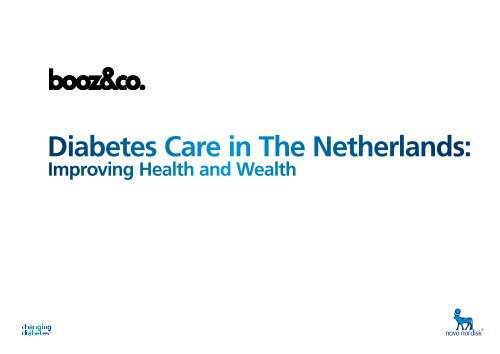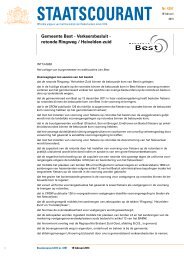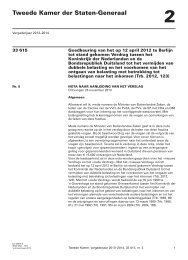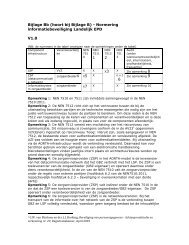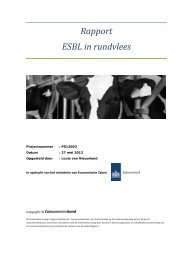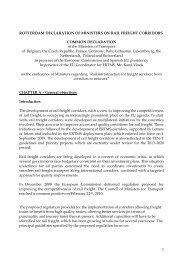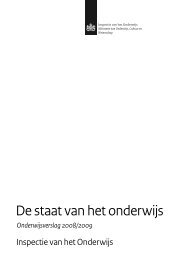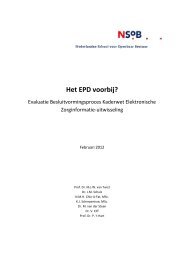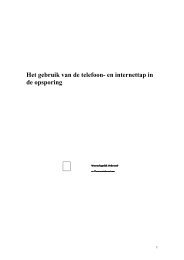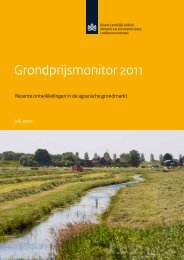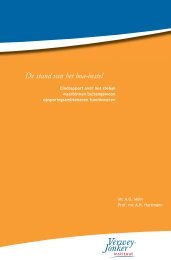Diabetes Care in The Netherlands: - Novo Nordisk
Diabetes Care in The Netherlands: - Novo Nordisk
Diabetes Care in The Netherlands: - Novo Nordisk
- No tags were found...
Create successful ePaper yourself
Turn your PDF publications into a flip-book with our unique Google optimized e-Paper software.
Summary<strong>Diabetes</strong> is a serious and demand<strong>in</strong>g disease. Complications canbe severe (e.g. stroke, heart disease, visual impairment, kidneydisease). Effective treatment allows most patients to live a lifeclose to normal, but diabetes treatment requires discipl<strong>in</strong>ed selfmanagement.Patients need to manage diets and exercise carefullyto control or lose weight, and most take daily medication. Insul<strong>in</strong>dependent diabetes patients need to closely match <strong>in</strong>sul<strong>in</strong> <strong>in</strong>takewith their diets and with their exercise <strong>in</strong>tensity. Too little <strong>in</strong>sul<strong>in</strong>will lead to long-term complications and too much <strong>in</strong>sul<strong>in</strong> maylead to hypoglycaemic episodes (hypos) – risk<strong>in</strong>g unconsciousness,coma and/or bra<strong>in</strong> damage. A frustrat<strong>in</strong>g side-effect of <strong>in</strong>sul<strong>in</strong>therapy is weight ga<strong>in</strong>.For society, diabetes is a source of medical costs and lostproductivity. Our analysis suggests that the problem may beunderestimated. While recogniz<strong>in</strong>g that further studies areneeded (especially where data sources are conflict<strong>in</strong>g), weestimate that there are already more than one million diabetespatients <strong>in</strong> the <strong>Netherlands</strong>. We estimate the costs of treatmentand complications of diabetes at EUR 2-3 billion, twice as high astypically reported. Add<strong>in</strong>g other medical costs, the total medicalcosts of diabetes patients are EUR 4-5 billion. In addition, weestimate that the costs associated with lost productivity fordiabetes patients are EUR 5-6 billion. More importantly, allestimates and sources have one th<strong>in</strong>g <strong>in</strong> common; they stress theimpact of diabetes on patients and society.Professionals and patients can be proud of diabetes care <strong>in</strong> the<strong>Netherlands</strong>. Quality of care is high compared to other countriesand the majority of patients enjoy a close to normal life. Evidencefrom a selection of primary care groups suggests that largequality ga<strong>in</strong>s have been realized s<strong>in</strong>ce the n<strong>in</strong>eties. For these caregroups, roughly two thirds of patients have blood glucose levels(HbA1c) below the target of 7% (53 mmol/mol).However, substantial non-compliance and apparent practicevariations <strong>in</strong> quality of care suggest that there is still potential tofurther improve the health of Dutch diabetes patients. Furtherimprov<strong>in</strong>g health of diabetes patients may lead to EUR 1.5-2 billionof medical cost and productivity benefits <strong>in</strong> 2020. <strong>The</strong> nationalprimary care benchmark for diabetes under development by thepatient federation and professionals will be important to developdetailed <strong>in</strong>sight <strong>in</strong> practice variation.Projected cost sav<strong>in</strong>gs from better care for people with chronicdiseases are sometimes received with scepticism, grounded <strong>in</strong>the idea that complications can be delayed but not avoided.But delay<strong>in</strong>g complications reduces the time that people livewith costly complications, and <strong>in</strong>creases participation <strong>in</strong> both4
the workforce and <strong>in</strong> social life. In addition to societal benefits,social participation is <strong>in</strong> itself also an effective stimulator for thewellbe<strong>in</strong>g of patients.We conclude that there are still important barriers to <strong>in</strong>novation,to quality improvement and to improv<strong>in</strong>g self-managementcapabilities for patients. <strong>The</strong> result is an environment that canbe frustrat<strong>in</strong>g for passionate professionals, patients and <strong>in</strong>surers.Our recommendations address these barriers. <strong>The</strong>y are <strong>in</strong>tendedto contribute to a more reward<strong>in</strong>g climate for quality, <strong>in</strong>novationand engagement of employers, participative care and the patient’ssocial network.Recommendation 1: Ref<strong>in</strong>e economic <strong>in</strong>centives toencourage <strong>in</strong>tegrated primary and specialist care andquality improvementCurrent economic <strong>in</strong>centives do not encourage qualityimprovement and <strong>in</strong>novation. Professionals are still primarilyrewarded for volume, not for quality of care. For <strong>in</strong>surers, sav<strong>in</strong>gsthat can be expected from <strong>in</strong>vest<strong>in</strong>g <strong>in</strong> quality are difficult totrace on the macro level and easily fail to materialize. Individualpatients may have fewer hospital admissions, doctor visits andother health care costs. However, there is a risk that second‘cash change’ does not occur <strong>in</strong>volv<strong>in</strong>g the closure of beds andsurgery <strong>in</strong>frastructure, redeployment of staff or reduction <strong>in</strong>procurement activity. Hence, the risk is that <strong>in</strong>surers pay double:for the <strong>in</strong>novation <strong>in</strong>itiative and for the unchanged volume ofregular care.Economic <strong>in</strong>centives should create more room for doctors, nursesand patients who are passionate about improv<strong>in</strong>g care. Ourproposed ref<strong>in</strong>ements <strong>in</strong>clude:• Integrate contract<strong>in</strong>g of primary care and specialist care<strong>in</strong> networks. Introduc<strong>in</strong>g a model where primary care andspecialists jo<strong>in</strong>tly evaluate diabetes patients. This furtherempowers primary care to treat diabetes patients. It alsoreduces the <strong>in</strong>cl<strong>in</strong>ation for specialists to ma<strong>in</strong>ta<strong>in</strong> patients <strong>in</strong>a specialist care environment. Volume agreements between<strong>in</strong>surers and health care providers are needed to ensurethat w<strong>in</strong>-w<strong>in</strong>s are traced and materialized. Ga<strong>in</strong>-shar<strong>in</strong>gcreates the right <strong>in</strong>centives to encourage cont<strong>in</strong>uousquality improvement (quality production <strong>in</strong>stead of volumeproduction) and will remove some of the frustrat<strong>in</strong>gdis<strong>in</strong>centives that so often block quality <strong>in</strong>itiatives.• Extra <strong>in</strong>surer compensation for diabetes patients <strong>in</strong> the riskequalization scheme. Incorporat<strong>in</strong>g a small profit marg<strong>in</strong>on diabetes patients <strong>in</strong> the risk equalization schemes willencourage competition between <strong>in</strong>surers on quality of5
diabetes care. Extra compensation will mitigate the riskthat <strong>in</strong>surers <strong>in</strong>vest<strong>in</strong>g <strong>in</strong> high quality care attract moref<strong>in</strong>ancially unattractive patients.• Build <strong>in</strong>frastructure for <strong>in</strong>tegrated primary care and specialistcare. <strong>The</strong> <strong>in</strong>tegrated fund<strong>in</strong>g model of network care shouldbe expanded to <strong>in</strong>clude hospital care for diabetes (e.g. by<strong>in</strong>corporat<strong>in</strong>g specialist care <strong>in</strong> the keten-DBC). Insurersshould support professionals <strong>in</strong> creat<strong>in</strong>g a support<strong>in</strong>g IT<strong>in</strong>frastructure.Recommendation 2: Engage employers, UWV andparticipative care <strong>in</strong> diabetes careEmployers, the UWV and participative care are still little engaged<strong>in</strong> diabetes care. <strong>The</strong>re is more economic benefit of better care<strong>in</strong> improv<strong>in</strong>g labour (and social) participation than <strong>in</strong> lower<strong>in</strong>gmedical cost. Productivity benefits will ga<strong>in</strong> even more importancegiven the expected tight labour market and the associated risksof wage <strong>in</strong>flation and wait<strong>in</strong>g lists for cure and care due topersonnel shortage.<strong>The</strong>re is a role for employers and government to contribute to<strong>in</strong>creased participation of diabetes patients.• Insurers can offer collective diabetes <strong>in</strong>surance modulesfocused on <strong>in</strong>creased participation of diabetes patients;• Companies and UWV can <strong>in</strong>vest <strong>in</strong> such collective <strong>in</strong>surancefor employees and welfare recipients (potentially negotiated<strong>in</strong> central labour agreements);• Insurers can <strong>in</strong>tegrate contract<strong>in</strong>g of participative andcurative care;• Participative care’s primary role should be to ensure awork<strong>in</strong>g environment that encourages patients to complywith therapy and that keeps patients motivated to keepwork<strong>in</strong>g as long as possible. Cop<strong>in</strong>g with a disease <strong>in</strong> astimulat<strong>in</strong>g environment can be highly complementary tothe more classical function of curative health care.Recommendation 3: Encourage the patient’s socialnetwork to support self-management<strong>The</strong> patient’s social network is not systematically engaged <strong>in</strong> thepatient’s care, leav<strong>in</strong>g many patients alone <strong>in</strong> self-management.For the majority of patients, regular doctor visits are sufficient,but for many this is not enough.Physicians should have tools to encourage support for patientswho need it. Patients and the patient federation should have akey role <strong>in</strong> develop<strong>in</strong>g these tools. We recommend:To <strong>in</strong>clude behavioral dimensions <strong>in</strong> medical guidel<strong>in</strong>es fordiabetes (e.g. family present at key doctor visits);6
• <strong>Diabetes</strong> is a challeng<strong>in</strong>g disease for patients– Treatment requires large behavioural change and poses a real risks of side effects– Complications from diabetes are potentially severe (e.g. stroke, kidney disease heart disease)– Fortunately high quality treatment and strict compliance has proven to keep diabetes patients healthy for a long time• <strong>Novo</strong> <strong>Nordisk</strong> has asked Booz & Co to perform a study with the objective to identify how our health care system could beimproved to empower professionals <strong>in</strong> provid<strong>in</strong>g high quality of care for diabetes• Better diabetes care has value for patients and society– Improves health of the patient: improv<strong>in</strong>g life expectancy and quality of life– Reduces health care cost: prevention, reduction, and delay<strong>in</strong>g of complications– Reduces the demand for <strong>in</strong>creas<strong>in</strong>gly scarce labour health care (ZorgInnovatiePlatfrom projects 450.000 vacant employmentpositions <strong>in</strong> health care <strong>in</strong> 2025)– Improves productivity by <strong>in</strong>creas<strong>in</strong>g workforce participation of diabetes patients• This document presents the f<strong>in</strong>d<strong>in</strong>gs of the study. It is <strong>in</strong>tended to serve as a basis for further discussion with patients, medicalprofessionals, policymakers and <strong>in</strong>surers8
ContentsSummarized f<strong>in</strong>d<strong>in</strong>gs and recommendations<strong>The</strong> opportunity• <strong>Diabetes</strong> is a major and underestimated source of medical costs and lost productivity• <strong>Diabetes</strong> care <strong>in</strong> <strong>The</strong> <strong>Netherlands</strong> has reached a high level of quality, but there is still opportunity for further improvement• Further improv<strong>in</strong>g health of patients may lead to EUR 1.5-2 B of economic benefits <strong>in</strong> 2020<strong>The</strong> road• Ref<strong>in</strong>e economic <strong>in</strong>centives to encourage <strong>in</strong>tegrated care and quality improvement• Engage employers, UWV and participative care <strong>in</strong> diabetes care• Engage the patient’s social network to support self management• Introduce conditional market access models for new therapies and medication to assess behavioural impactAppendix: list of sources9
Ma<strong>in</strong> conclusionsObjectiveFurther improvehealth forpatients andsociety11<strong>Diabetes</strong> is a is challeng<strong>in</strong>g a challeng<strong>in</strong>g disease disease for patients, for patients, and a major and and a major underestimated and source ofmedical underestimated costs and lost source productivity of medical for society costs and lost productivity for society• 1.0-1.1M 1.0-1.1M diabetes diabetes patients patients (~100,000 (~100,000 more diagnosed more diagnosed patients patients than reported) than reported)• EUR 4-5 EUR B total 4 -5 medical B total costs medical for costs diabetes for diabetes patients, patients, of which of EUR which 2.5 EUR B costs 2.5 for B costs diabetestreatment for and diabetes complications treatment (more and complications than double of (more reported). than On double top of that reported). EUR 6 On B lost topproductivity of that EUR 6 B lost productivity• Total costs Total could costs rise could to EUR rise 16-19 to EUR B 16 <strong>in</strong> 2020 -19 B <strong>in</strong> 2020• <strong>Diabetes</strong> care <strong>in</strong> <strong>The</strong> <strong>Netherlands</strong> has reached a high level of quality, but22<strong>Diabetes</strong> care <strong>in</strong> <strong>The</strong> <strong>Netherlands</strong> has reached a high level of quality, but there is stillopportunity there is still for further opportunity improvement for further improvementFurther improv<strong>in</strong>g health of diabetes patients may lead to EUR 1.5 -2 B ofeconomic benefits <strong>in</strong> 2020 (less medical costs and higher productivity)33Further improv<strong>in</strong>g health of diabetes patients may lead to EUR 1.5-2 B of economic benefits <strong>in</strong>2020 (less medical costs and higher productivity)Insurers and governments should adjust certa<strong>in</strong> economic <strong>in</strong>centives to11 Ref<strong>in</strong>e stimulate economic high <strong>in</strong>centives quality to care encourage <strong>in</strong>tegrated care and quality improvement<strong>The</strong> roadFewer barriersfor quality <strong>in</strong> ourhealth caresystemTo <strong>in</strong>crease labour participation, government and companies can <strong>in</strong>vest <strong>in</strong>diabetes care via collective <strong>in</strong>surance models22Engage employers, UWV and participative care <strong>in</strong> diabetes care3 Engage the patient’s social network to support self managementInsurers , patient federations and Pharma companies could facilitate34 Introduce conditional market access models for new therapies and medication to assessnetwork solutions around the patient to support better diabetes carebehavioural impact4Government and <strong>in</strong>surers could <strong>in</strong>troduce temporary medication marketaccess models to assess impact on therapy complianceBooz & Company 14 November 201110Prepared for <strong>Novo</strong> <strong>Nordisk</strong>2
11<strong>Diabetes</strong> is a major and underestimated source of medical costs<strong>Diabetes</strong> is major and underestimated source ofand medical lost costs productivity and lost productivityMore than 1M diabetes patients <strong>in</strong> the <strong>Netherlands</strong>2010; ‘000<strong>Diabetes</strong> Type 1 may be more prevalent than assumed2010; ‘000Higherprevalence~710-850~920-975~95-190~1,0 M-1.1 M75-90~100--125More costsDiagnosedother sources1)DiagnosedBooz estimateUndiagnosed2)TotalTraditional estimateBooz estimateCosts of complications and treatment diabetes double of reported. Lost productivity more than medical costsEUR B , 20101.21.3X22-31.84-5>X25-610-1158%42%Type 2Type 1Reportedmedical costs (RIVM)Unreportedcost of complications~1.4 M <strong>Diabetes</strong> Patients <strong>in</strong> 2020MCosts diabetestreatment andcomplicationsOther medical costsfor diabetes patientsTotal medical costsfor diabetes patientsLost productivitydisabledMedical andproductivity costsdiabetes patientsTotal costs could rise to EUR 16-19 BEUR BFaster growth1.0-1.1+3%1.3-1.5Cost grow faster due to<strong>in</strong>creas<strong>in</strong>g share ofdiabetes patients <strong>in</strong>workforce age10-11+5%16-1920102020201020201) Other sources <strong>in</strong>clude CBS (710), DVN (750) and RIVM (850) (2) Range between 10% and 20%Source: CBS, DVN, RIVM, SFK, Janssen et al. Screen<strong>in</strong>g Study, DFN, IDF, CMR-Nijmegen, ADA, <strong>Diabetes</strong> Richtlijnen, DBC pricelist 2011, <strong>Diabetes</strong>ZorgBeter, UWV, Booz & Company AnalysisBooz & Company 14 November 2011Prepared for <strong>Novo</strong> <strong>Nordisk</strong>411
2 2<strong>Diabetes</strong> care <strong>in</strong> <strong>The</strong> <strong>Netherlands</strong> has reached a a high level of ofquality, but but there there is is still still opportunity for for further further improvementimprovement<strong>Diabetes</strong> care clearly improved <strong>in</strong> <strong>The</strong> <strong>Netherlands</strong>Selected <strong>Care</strong> Groups– 1996-2010<strong>Diabetes</strong> care clearly improved <strong>in</strong> <strong>The</strong> <strong>Netherlands</strong>Selected <strong>Care</strong> Groups – 1996-20107.5%1996Average HbA1c values now below target value7.1%2000-20076.7%2008Target value
33Further improv<strong>in</strong>g health of of diabetes patients may lead lead to to EUR 1.5 -EUR 2 B of 1.5-2 economic B of economic benefits benefits <strong>in</strong> 2020 <strong>in</strong> 2020Estimated Economic BenefitsEUR M , 20201.000-1.5001.500 – 2.000Fully disabled400-600Partially disabledPresenteeismAbsenteeismComments:Less medical costs fromreduction <strong>in</strong>complicationsReduction of lost productivityMedical costs andproductivity benefitsSource: Booz & Company AnalysisBooz & Company 14 November 2011• Reduction <strong>in</strong> cost due toless complications• Reduction <strong>in</strong> <strong>in</strong>flow of newwork<strong>in</strong>g disabilities• Reduction of ab- andpresenteeism <strong>in</strong> l<strong>in</strong>e withreduction <strong>in</strong> complicationsPrepared for <strong>Novo</strong> <strong>Nordisk</strong>613
11Recommendation 1: Ref<strong>in</strong>e economic <strong>in</strong>centives to encourage<strong>in</strong>tegratedRecommendationcare and1:qualityRef<strong>in</strong>eimprovementeconomic <strong>in</strong>centives to encourage<strong>in</strong>tegrated care and quality improvementBarrierCurrenteconomic<strong>in</strong>centives donot encouragequalityimprovementand <strong>in</strong>novationDiagnosis• Insurers are support<strong>in</strong>g quality improvement, but theyare confronted with (perceived) f<strong>in</strong>ancial dis<strong>in</strong>centives- High quality care is perceived to only delay complications andcost (however, an <strong>in</strong>dicative analysis suggest ~25% life timecost reduction if complications are delayed with 3 years)- Differences <strong>in</strong> risk exposure for specialist and primary care- Higher quality diabetes care may attract more loss-mak<strong>in</strong>gpatients for the <strong>in</strong>surer- (Hospital) capacity that is freed up by quality improvementstends to fill up with other patients (lead<strong>in</strong>g to double cost)• Limited collaboration <strong>in</strong>centive for primary care andspecialist care• Quality improvement <strong>in</strong>itiatives are frustrated byfragmented budget<strong>in</strong>g (and ad hoc budget cuts)• Individual quality <strong>in</strong>centives are lack<strong>in</strong>g for Primary <strong>Care</strong>,Specialists and Patient• Significant evidence gaps <strong>in</strong> basic statistics and <strong>in</strong>treatment evidence suggest <strong>in</strong>sufficient support<strong>in</strong>g<strong>in</strong>centives for critical researchRecommendationInsurer• Integrate contract<strong>in</strong>g of primarycare and specialist care <strong>in</strong> networks• Provide patient <strong>in</strong>centive forcompliance (bonus miles, ga<strong>in</strong>shar<strong>in</strong>g)• Enable research fund<strong>in</strong>g fromregular budgetGovernment• Adjust risk equalization scheme toensure small profit marg<strong>in</strong> ondiabetes patients for <strong>in</strong>surers• Create an <strong>in</strong>tegrated fund<strong>in</strong>g modelfor primary and specialist carenetworksBooz & Company 14 November 2011Prepared for <strong>Novo</strong> <strong>Nordisk</strong>714
22Recommendation 2: Engage employers, UWV and participativecareRecommendation<strong>in</strong> diabetes care2: Engage employers, UWV and participativecare <strong>in</strong> diabetes careBarrier Diagnosis RecommendationEmployers,UWV andparticipativecare are stilllittle engaged <strong>in</strong>diabetes care• Age<strong>in</strong>g will create an extremely tight labour market overthe com<strong>in</strong>g decade• Labour shortage from late n<strong>in</strong>eties illustrates the risk forour economy• <strong>Diabetes</strong> has a high prevention potential for lostproductivity- 92,000 of work<strong>in</strong>g disabled have diabetes,• However, curative and participative care (arbo- andbedrijfsarts) are still two different worldsInsurer• Offer collective <strong>in</strong>surance modules fordiabetes to <strong>in</strong>crease the participationof diabetes patients• Integrate contract<strong>in</strong>g of participativeand curative careCompanies and UWV• Invest <strong>in</strong> collective <strong>in</strong>surance foremployees and welfare recipientsParticipative care• Ensure a work<strong>in</strong>g environment thatencourages compliance andmotivates to work as long as possibleBooz & Company 14 November 2011Prepared for <strong>Novo</strong> <strong>Nordisk</strong>815
3Recommendation 3: Engage the patient’s social network to supportself managementRecommendation 3: Engage the patient’s social network tosupport self managementBarrier Diagnosis Recommendation<strong>The</strong> socialnetwork is notsystematicallyengaged <strong>in</strong>patient’s care• Medical treatments for <strong>Diabetes</strong> Type 1 and Type 2can be effective, however compliance is a hugechallenge- Effects of non-compliance are severe- Non compliance is a challenge of distant benefits and largerequired behavioural change• Facilitated patient networks are successful <strong>in</strong> otherdistant benefits – high behavioural change conditions• Examples of patient networks for other conditions (e.g.obesitas) can be <strong>in</strong>structive for diabetes• Integrated behavioural <strong>in</strong>terventions have beensuccessful <strong>in</strong> improv<strong>in</strong>g compliance (e.g. KaiserPermanente Evidence)Medical professionals: Includebehavioural dimension <strong>in</strong> medicalguidel<strong>in</strong>es• Include family <strong>in</strong> standard treatment(e.g. family at key doctor visits)• Add checklist for align<strong>in</strong>g treatment withpersonal life (mass customization)<strong>Novo</strong> <strong>Nordisk</strong>: Scale-up social media• Scale-up diabetes health communitieswith patients and their professionals(mijn zorgpag<strong>in</strong>a DVN, mijnzorgnet)<strong>Novo</strong> <strong>Nordisk</strong>: Educate amateur coachesfor non-adherent patients• Develop screen<strong>in</strong>g <strong>in</strong>strument forcoach<strong>in</strong>g eligibility for physicians• Educate amateur coaches• Select professional coaches <strong>in</strong> aselected group of complicated casesBooz & Company 14 November 2011Prepared for <strong>Novo</strong> <strong>Nordisk</strong>916
44Recommendation 4: Introduce conditional market access modelsforRecommendationnew therapies4:andIntroducemedicationconditionalto assessmarketbehaviouralaccessimpactmodelsfor new therapies and medication to assess behavioural impactBarrier Diagnosis RecommendationDecisions on<strong>in</strong>surancecoverage tendto undervaluebehaviouralimpact• Optimal treatment with current generation of diabetesmedication is therapeutically highly effective if patientsare compliant• But new medication could add a lot of value <strong>in</strong> boost<strong>in</strong>gcompliance• CFH medication access criteria allow evaluation of impacton compliance, however the required evidence is usuallynot generated by trialsGovernment and <strong>in</strong>surer• Def<strong>in</strong>e models that allow forconditional access to proof<strong>in</strong>direct effects on compliance• Include compliance <strong>in</strong> theguidel<strong>in</strong>es as a factor driv<strong>in</strong>g thechoice of medicationsBooz & Company 14 November 2011Prepared for <strong>Novo</strong> <strong>Nordisk</strong>1017
ContentsSummarized f<strong>in</strong>d<strong>in</strong>gs and recommendations<strong>The</strong> opportunity• <strong>Diabetes</strong> is a major and underestimated source of medical costs and lost productivity• <strong>Diabetes</strong> care <strong>in</strong> <strong>The</strong> <strong>Netherlands</strong> has reached a high level of quality, but there is still opportunity for further improvement• Further improv<strong>in</strong>g health of patients may lead to EUR 1.5-2 B of economic benefits <strong>in</strong> 2020<strong>The</strong> road• Ref<strong>in</strong>e economic <strong>in</strong>centives to encourage <strong>in</strong>tegrated care and quality improvement• Engage employers, UWV and participative care <strong>in</strong> diabetes care• Engage the patient’s social network to support self management• Introduce conditional market access models for new therapies and medication to assess behavioural impactAppendix: list of sources18
Already more than 1M diabetes patients <strong>in</strong> the <strong>Netherlands</strong> -Already more than 1M diabetes patients <strong>in</strong> the <strong>Netherlands</strong> -~100.000 more diagnosed than usually reportedNumber of <strong>Diabetes</strong> PatientsNumber of <strong>Diabetes</strong> Patients2010, ‘0002010, ‘00095-190~1.0-1.1M850920-975710Type 2557752795-875Total number of diabetes patientsthat use medication plus estimated10% to 15% patients that use nomedicationType 115398100-125CBS : based onpatient surveyRIVM based on sample ofGP registrations (2007figure extrapolated to 2010)Booz estimate(based on SFK dataon diabetesmedication users)Undiagnosed (basedon ’02-’04 study <strong>in</strong>southwest NL) 1Total number of diabetespatients (estimated)(1) Based on study of 50-70 years old patients. Undiagnosed rate of 10-20% has been extrapolated. SFK reports 830.000 patients on diabetes medication. SFK data covers 92% of the market. We have notscaled up SFK numbers because there is also a fraction of over-registration SFK data (~5-10%) as some people tak<strong>in</strong>g medications from multiple pharmacies are counted twiceBooz & Company 14 November 2011Prepared for <strong>Novo</strong> <strong>Nordisk</strong>Source: CBS, RIVM, SFK, Janssen et al. Screen<strong>in</strong>g study, Booz & Company Analysis1219
<strong>Diabetes</strong> Type 1 may be more prevalent than assumed – but databut sources data are sources highly are conflict<strong>in</strong>g highly conflict<strong>in</strong>gNumber of <strong>Diabetes</strong> Type I Patients based ondifferent sources2010, ‘000CommentsCommentsDVN / DFN1501)• DVN and NDF quote 150,000 Type 1 patients (methodology not further expla<strong>in</strong>ed)• This translates <strong>in</strong>to 20% of diagnosed diabetes patientsCBSBased on sample<strong>in</strong> BrabantRIVM98153163• Survey sample <strong>in</strong> which patients respond<strong>in</strong>g yes to 3 questions were identified as Type1: (1) Do you have diabetes? (2) Do you use <strong>in</strong>sul<strong>in</strong> for this? (3) Did you start us<strong>in</strong>g<strong>in</strong>sul<strong>in</strong> with<strong>in</strong> 6 months after be<strong>in</strong>g diagnosed?• Drawback of methodology is that the answers to the questions may not be a reliableproxy for share of Type 1 patients• PoZoB (GP support Brabant) <strong>in</strong>cludes 15,500 <strong>Diabetes</strong> Type 2 patients <strong>in</strong> theirprograms, of which 14% uses <strong>in</strong>sul<strong>in</strong>• Extrapolat<strong>in</strong>g this to the national level, and with a total of 285,000 <strong>in</strong>sul<strong>in</strong> users(source SFK), this would imply 162.500 Type 1 patients• RIVM estimates 10% Type 1 of diagnosed patients, based on GP registration• Drawback of methodology is that maybe not all Type 1 patients are registered by GP,such that GP registrations are not fully accurateInternational<strong>Diabetes</strong> Federation98• IDF estimates 10% Type 1 of diagnosed patients, however not NL specificCMR -Nijmegen96Range• CMR -Nijmegen estimates 9.8% Type 1 (‘05-’08 period) of diagnosed patients, based onGP registration <strong>in</strong> Nijmegen• Drawback of methodology is that representatively may be questionableEstimate100125• Booz estimates 100,000 to 150,000 Type 1 patients, based on different sources• For calculation purposes the average of 125,000 will be used1) 2011 estimateSource: DVN/DFN, CBS, RIVM, IDF, CMR-Nijmegen, Booz & Company analysisBooz & Company 14 November 2011 Prepared for <strong>Novo</strong> <strong>Nordisk</strong>1320
Costs of of complications and treatment of of diabetes diabetes double double of ofreported, lost productivity more than medical costs costsCost of diabetesEUR B , 2010>X21.21.3In 2007 the average cost ofdiabetes patients was EUR 4,443 /year <strong>in</strong> comparison to the nationalaverage of EUR 1,646 / yearX22-31.84-50.22.63.510-11Type 258%42%Type 1• Complications andlost productivity /welfare assumed100% distributedas <strong>in</strong>sul<strong>in</strong> patients• Other costassumed 70%distributed as<strong>in</strong>sul<strong>in</strong> patientsand 30% totalpatients• Insul<strong>in</strong> patients:Type 1 ~45%Type 2 ~65%CommentsReportedmedicalcosts ( RIVM)Estimated byRIVMUnreportedcost ofcomplicationsBottom up BoozestimateCosts diabetestreatment andcomplicationsOthermedical costsfor diabetespatients 1)Difference betweenmedical costs forpatients with diabetesand medical costs fortreatment andcomplications ofdiabetesTotal medicalcosts fordiabetespatientsBased on totalmedical costsfor diabetespatients(NPCF )Absenteeism &presenteeismEffect of hyposon absence fromand <strong>in</strong>efficiencyat work, basedon ADF study(but numbersvary <strong>in</strong> differentpublications)WelfarepaymentsdisabledBased on 75% ofmodal <strong>in</strong>come *and 98,000disabled withdiabetesLostproductivitydisabledBased on modal<strong>in</strong>come and98,000 disabledMedical andproductivitycosts diabetespatients1) Other unreported medical costs <strong>in</strong>clude costs caused by additional use of medical care by diabetes patients; 2007 estimateBooz & Company 14 November 2011 Prepared for <strong>Novo</strong> <strong>Nordisk</strong>Source: NPCF, ADF, CBS, RIVM, SFK, <strong>Diabetes</strong>ZorgBeter, <strong>Diabetes</strong> Richtlijnen, DBC pricelist 2011, Booz & Company Analysis1421
Costs of diabetes complications and treatments areunderestimatedCosts of diabetes complications and treatments areMedical costs for diabetes patientsEUR M , 2010BACK -UP~4,000-5,000~1,800OtherSecond l<strong>in</strong>eNerves (neuropathy)Eyes (ret<strong>in</strong>opathy)Kidney dialyseHeart failure& diseaseX2~1,20052167 158 104Stroke~1,300305853518952,000-3,000Medications684Cost of treatment ofdiabetes andcost of complicationsunique to diabetes 1)Unreported costsof complications 2)Costs diabetes treatmentand complicationsOther medical costsfor diabetes patients 3)Booz estimate total medicalcosts for diabetes patients1) Other <strong>in</strong>cludes other health care providers and ma<strong>in</strong>tenance; costs of diabetic foot and hypos are <strong>in</strong>cluded <strong>in</strong> the second l<strong>in</strong>e2) Cost of direct treatment of complication for heart disease, eyes and nerves; lifetime costs of stroke, heart failure and kidney dialyse3)3)OtherOtherunreportedunreportedmedicalmedicalcostscosts<strong>in</strong>clude<strong>in</strong>cludecostscostscausedcausedbybyadditionaladditionaluseuseofof medicalmedicalcarecarebybydiabetesdiabetespatientspatientsSource: NPCF, RIVM kostenvanziekten.nl, <strong>Diabetes</strong>ZorgBeter , <strong>Diabetes</strong> Richtlijnen , DBC pricelist 2011, Booz & Company analysisSource: NPCF, RIVM kostenvanziekten.nl, <strong>Diabetes</strong>ZorgBeter, <strong>Diabetes</strong> Richtlijnen, DBC pricelist 2011, Booz & Company analysisBooz & Company 14 November 2011Prepared for <strong>Novo</strong> <strong>Nordisk</strong>2215
Number of patients reaches ~1.4M <strong>in</strong> 2020Total number of Diabetic patientsUndiagnosedDiagnosed‘0002.6%~1350-1475601990Diagnosed Type 13.7%‘0002.5%83 125 1602000 2010 2020• Past figuresextrapolatedfrom CBS data• Future growthma<strong>in</strong>ta<strong>in</strong>ed ataverage growth• Estimate type 1based on higherend of range 2010~5503.4%~900~1000-1100220Diagnosed Type 26.8%445‘0002.6%8251,070• Past figuresextrapolatedfrom RIVM• Future growthbased on actualType 2 growth2000 to 20101990200020102020Diagnosedrate1990 2000 2010 202050% 60% 80-90% 80-90%280Undiagnosed-3.4%‘0002.8%360140 185• Past rate basedon quotes• Current rateexpected to bestable <strong>in</strong> future19902000 2010 2020Source: RIVM, SFK CBS, Booz & Company analysisSource: RIVM, SFK CBS, Booz & Company analysisBooz & Company 14 November 2011Prepared for <strong>Novo</strong> <strong>Nordisk</strong>1623
Medical costs costs and and lost lost productivity of diabetes of patients could could riseto rise ~ EUR to ~ 16-19 EUR B 16-19 BTotal cost of <strong>Diabetes</strong> to SocietyEUR B , 2010-202016-196.5Lost productivity disabled10-113.54.8Welfare payments2.60.21.81.31.220100.52.31.71.62020Absenteeism & presenteeismOther medical costCost of complicationsDirect medical costSource: Source: RIVM, Booz RIVM, & Booz Company & Company Analysis AnalysisBooz & Company 14 November 2011Prepared for <strong>Novo</strong> <strong>Nordisk</strong>1724
Increase <strong>in</strong> lost productivity is driven by an <strong>in</strong>creas<strong>in</strong>g number ofdiabetes patients <strong>in</strong> workforce (~380k <strong>in</strong> 2020)Increase <strong>in</strong> lost productivity is driven by an <strong>in</strong>creas<strong>in</strong>g number ofIncrease and breakdown of diabetes patients <strong>in</strong> workforce2010 - 2020, ‘000• Disability estimates based on welfareregistration of the UWV• Reflects the number of disabled with diabetesBACK -UPYounger diabetic populationRetirement age 67Net <strong>in</strong>crease patients ’10 – ‘20261117202275~3801892424Work<strong>in</strong>g withdisability assumed30% disabled1412010Total workforcediabetes patientsIncrease ’10to ’202020Number ofdiabetics<strong>in</strong> workforceWork<strong>in</strong>g withwith nodisabilityWork<strong>in</strong>g withdisabilitywithoutadjustmentsWork<strong>in</strong>g withdisabilitywith adjustmentsOne out of three new diabetes patients <strong>in</strong> the workforce will beType 1 patientsNot ableto workSource:CBS, UWV, Booz & Company AnalysisBooz & Company 14 November 2011Prepared for <strong>Novo</strong> <strong>Nordisk</strong>1825
ContentsSummarized f<strong>in</strong>d<strong>in</strong>gs and recommendations<strong>The</strong> opportunity• <strong>Diabetes</strong> is a major and underestimated source of medical costs and lost productivity• <strong>Diabetes</strong> care <strong>in</strong> <strong>The</strong> <strong>Netherlands</strong> has reached a high level of quality, but there is still opportunity for further improvement• Further improv<strong>in</strong>g health of patients may lead to EUR 1.5-2 B of economic benefits <strong>in</strong> 2020<strong>The</strong> road• Ref<strong>in</strong>e economic <strong>in</strong>centives to encourage <strong>in</strong>tegrated care and quality improvement• Engage employers, UWV and participative care <strong>in</strong> diabetes care• Engage the patient’s social network to support self management• Introduce conditional market access models for new therapies and medication to assess behavioural impactAppendix: list of sources26
<strong>Diabetes</strong> care clearly improved <strong>in</strong> the <strong>Netherlands</strong> – Values froma selected group of care providers<strong>Diabetes</strong> care clearly improved <strong>in</strong> the <strong>Netherlands</strong> – Values from a7.5%HbA1c values (target value 7% - 53 mmol/mol)HbA1c < 7% / 53 mmol/mol% of patientsILLUSTRATIVE7.1%66.5%69.0%6.7%6.8%60.6%63.0%NA19962000-20072008201019962003200420082010Systolic blood pressuremmHgCholesterol levelmmol/l1556.01455.11381384.54.719962000-20072008201019962000-20072008 2010Note: 1996 data based on 5 networks of GP’s; 2000-2007 data based on all publications from GP’s; 2003 and 2004 hbA1c values < 7% based on study with 7,893 patients spread of NL; 2008 data based on studywith 14,156 patients from 8 networks and cholesterol voor level from met <strong>Diabetes</strong>ZorgBeter diabetes mellitus type networks; 2 <strong>in</strong> de 2010 1e lijn, data Interview based on Prof. 52,630 G.E.H.M patients Rutten, <strong>in</strong> 6 Julius networks Center, Booz & Company analysisSource: <strong>Diabetes</strong>zorggroepen en de keten-DBC, Zorg voor patienten met diabetes mellitus type 2 <strong>in</strong> de 1e lijn, Interview Prof. G.E.H.M Rutten, Julius Center, Booz & Company analysisBooz & Company 14 November 2011Prepared for <strong>Novo</strong> <strong>Nordisk</strong>2027
High quality care leads to excellent outcome values and to fewercomplicationsCASE EXAMPLES<strong>Diabetes</strong>ZorgBeter 1 st l<strong>in</strong>e protocolreduces risk of major complicationsFrequency of diabetic complications(2008)PoZoB achieves HbA1c objectives with~70% of the patients – also improvements<strong>in</strong> blood pressure and cholesterol levelsIndicators DM (2007 -2010)Through personalized coach<strong>in</strong>g Kaiserpermanente reduces HbA1c by 1.2%Change HbA1c values (1999)ChronicheartfailureAcute 0.7%heartfailure 0.3%2.1%1.0%HbA1c < 7% (
Better compliance can be stimulated and leads to fewerhospitalizationsBetter compliance can be stimulated and leads to fewerCASE EXAMPLESMedical cost of fully compliant patients up to half ofnon-compliant patientsAverage Expenditure per year (USD, 2005)44% reduction <strong>in</strong> hospitalizations atKaiser permanente programHospitalization/1000 persons -months (1999)$8,878-49%$7,124$6,522$6,29127-44%$4,571151-19%20-39%40-59%60-79%Compliance Levels (% Days Supply / 1 Year)80-100%ControlgroupKaiserpermanenteMa<strong>in</strong> <strong>in</strong>terventions• Compliance to treatment plan:- Medication- Doctor’s visits- Lifestyle advice (quit smok<strong>in</strong>g, etc.)Ma<strong>in</strong> <strong>in</strong>terventions• Focus on poorly managed diabetespatients• Personalized coach<strong>in</strong>g• Patient networks on- and off-l<strong>in</strong>eSource: Sokol M et al. Impact of Medication Adherence on Hospitalization Risk and Healthcare cost, Kaiser permanente, Booz & Company analysisBooz & Company 14 November 2011Prepared for <strong>Novo</strong> <strong>Nordisk</strong>2229
Clear potential <strong>in</strong> <strong>in</strong> high quality treatment implementation and andcompliance improvementILLUSTRATIVEPrimary care protocol canbr<strong>in</strong>g life expectancy of Type2 patients to normal levelsRegional variances <strong>in</strong> care patterns arestill high% of Type 2 <strong>in</strong>sul<strong>in</strong> patient <strong>in</strong> first l<strong>in</strong>e (2008 )Non-compliance significant asdifferent studies <strong>in</strong>dicateArticle:Life expectancy <strong>in</strong> a largecohort of type 2 diabetespatients treated <strong>in</strong> primarycareLutgers LH, Gerrits EG,Sluiter WJ, Ub<strong>in</strong>k-VeltmaatLJ, Landman GWD, L<strong>in</strong>ksTP, Gans ROB, Smit AJ,Bilo HJG; (ZODIAC-10).PlosOne 2009;% of <strong>in</strong>sul<strong>in</strong> patientsZwolle Region Region RegionRegion19 %Region Region% of patients with HbA1c < 7% per health care group <strong>in</strong>2009 & 201068%68%67%63%61%59%Studies of therapy adherence on theDutch diabetes Type 2 patientsPaes e.a.; 1998:<strong>The</strong>rapy adherence related to:• Frequency of dosage 66-99%• Prescribed doses 38-79%Cramer; 2004:General <strong>The</strong>rapy adherence• Type 2 diabetes 36-93%56%Selected care groups <strong>in</strong> <strong>The</strong> <strong>Netherlands</strong>Professionals and DVN are develop<strong>in</strong>g national primary carebenchmark for diabetes for more <strong>in</strong>sight <strong>in</strong> practice variationsSource: <strong>Diabetes</strong>ZorgBeter Prof H. Bilo, PoZoB, Kaiser permanente , <strong>Diabetes</strong>zorg Zorggroepen Nederlandse Huisartspraktijken - van Rutten, Booz & Company analysisSource: <strong>Diabetes</strong>ZorgBeter - Prof H. Bilo, PoZoB, Kaiser permanente, <strong>Diabetes</strong>zorg Zorggroepen Nederlandse Huisartspraktijken - van Rutten, Booz & Company analysisBooz & Company 14 November 2011Prepared for <strong>Novo</strong> <strong>Nordisk</strong>3023
ContentsSummarized f<strong>in</strong>d<strong>in</strong>gs and recommendations<strong>The</strong> opportunity• <strong>Diabetes</strong> is a major and underestimated source of medical costs and lost productivity• <strong>Diabetes</strong> care <strong>in</strong> <strong>The</strong> <strong>Netherlands</strong> has reached a high level of quality, but there is still opportunity for further improvement• Further improv<strong>in</strong>g health of patients may lead to EUR 1.5-2 B of economic benefits <strong>in</strong> 2020<strong>The</strong> road• Ref<strong>in</strong>e economic <strong>in</strong>centives to encourage <strong>in</strong>tegrated care and quality improvement• Engage employers, UWV and participative care <strong>in</strong> diabetes care• Engage the patient’s social network to support self management• Introduce conditional market access models for new therapies and medication to assess behavioural impactAppendix: list of sources31
FurtherFurtherimprov<strong>in</strong>gimprov<strong>in</strong>ghealthhealth ofofpatientspatientsmaymayleadleadtotoEUREUR1.51.5-2-2 B ofB ofeconomic benefits <strong>in</strong> 2020economic benefits <strong>in</strong> 2020Reduction <strong>in</strong> cost ofcomplications:~ EUR 0.5 B• Estimated based on a comb<strong>in</strong>ation of improved compliance and an <strong>in</strong>creased reachof high quality care. Two high-level approaches result <strong>in</strong> a similar estimate– A Kaiser Permanente study shows that total medical cost of 80-100% compliantpatients are ~25 -30% lower than of patients who are 60-80% compliant– If the national average would show the same relative risk of complications as <strong>in</strong>the <strong>Diabetes</strong>ZorgBeter study, this would reduce cost of complications by morethan 30%• <strong>The</strong> comb<strong>in</strong>ation of improved care and improved compliance may have higherpotential~ EUR 1.5 – 2 BReduction of lostproductivity:~ EUR 1.2 B• Absenteeism and presenteeism and the related cost decl<strong>in</strong>e <strong>in</strong> l<strong>in</strong>e with theexpected decl<strong>in</strong>e <strong>in</strong> the number of complications• Assumption is that 50% of the <strong>in</strong>flow of disabled <strong>in</strong> the workforce with diabetes,would have been able to rema<strong>in</strong> active <strong>in</strong> the workforce if there would not havebeen diabetes complications• Estimate is that 50% <strong>in</strong>flow can be reduced <strong>in</strong> l<strong>in</strong>e with the assumed reduction <strong>in</strong>the number of complications (~30%)Source:CBS, CBS, <strong>Diabetes</strong>Zorg Beter study, UWV, UWV, Booz Booz & Company & AnalysisBooz & Company 14 November 201132Prepared for <strong>Novo</strong> <strong>Nordisk</strong>25
ContentsSummarized f<strong>in</strong>d<strong>in</strong>gs and recommendations<strong>The</strong> opportunity• <strong>Diabetes</strong> is a major and underestimated source of medical costs and lost productivity• <strong>Diabetes</strong> care <strong>in</strong> <strong>The</strong> <strong>Netherlands</strong> has reached a high level of quality, but there is still opportunity for further improvement• Further improv<strong>in</strong>g health of patients may lead to EUR 1.5-2 B of economic benefits <strong>in</strong> 2020<strong>The</strong> road• Ref<strong>in</strong>e economic <strong>in</strong>centives to encourage <strong>in</strong>tegrated care and quality improvement• Engage employers, UWV and participative care <strong>in</strong> diabetes care• Engage the patient’s social network to support self management• Introduce conditional market access models for new therapies and medication to assess behavioural impactAppendix: list of sources33
Insurers are support<strong>in</strong>g quality improvement, but they areconfrontedInsurers arewithsupport<strong>in</strong>g(perceived)qualityf<strong>in</strong>ancialimprovement,dis<strong>in</strong>centivesbut they areconfronted with (perceived) f<strong>in</strong>ancial dis<strong>in</strong>centivesPerception that <strong>in</strong>vest<strong>in</strong>g <strong>in</strong> diabetes care is only delay<strong>in</strong>g and notelim<strong>in</strong>at<strong>in</strong>g complications and therefore not generat<strong>in</strong>g revenues• This perception is <strong>in</strong>valide but will need to be addressed specificallyLowDifferences <strong>in</strong> risk exposure to primary care and specialist• <strong>The</strong> risk and budget allocation mechanism lead to a lower risk burden for the<strong>in</strong>surer for hospital care versus primary careImpactHigh quality diabetes care may attract more than fair-share diabetespatients• <strong>Diabetes</strong> patients seem to be on average loss-mak<strong>in</strong>g even after budgetallocation corrections(Hospital) capacity that is freed up by quality improvements, tends to fillup with other patients (lead<strong>in</strong>g to double cost)• Cost benefits on the patient-level often lost due to extra volume from otherpatientsHighInsurers do <strong>in</strong>vest <strong>in</strong> <strong>in</strong>itiatives – but they tend to see it as a qualitydifferentiator with no or modest economic benefitsSource:Booz & Company analysisBooz & Company 14 November 201134Prepared for <strong>Novo</strong> <strong>Nordisk</strong>27
Delay<strong>in</strong>g complications saves medical costs – despite occasionalskepticismILLUSTRATIVE16.3NPV12.4Illustration: calculation, the value of 3year delay of complicationsNPV, annual costs EUR ‘000-24%42Illustration is for a 60 yearold male patient alreadydiagnosed060 61 62 63 64 65 66 67 68 69 70 71 72 73 74 75AgePatient of 60 years old diagnosed with Type 2 diabetes.assum<strong>in</strong>g complications will occur after 5 yearsCost if we would be able to delay complications with3 years with an <strong>in</strong>tervention, less complications occurr<strong>in</strong>gafter 8 yearsCost per year (based on average costs oftreatment and complications, excl. other medical costsEUR ‘000105010%5%0%10%5%0%60 61 62 63 64 65 66 67 68 69 70 71 72 73 74 75AgeAttrition%60 61 62 63 64 65 66 67 68 69 70 71 72 73 74 75AgeMortality%60 61 62 63 64 65 66 67 68 69 70 71 72 73 74 75AgeDetails• Given that patient is aliveand rema<strong>in</strong>s with<strong>in</strong><strong>in</strong>surance plan• Complications assumedto occur after 5 years• Assumed that<strong>in</strong>tervention can delaycomplications for 3 years• Attrition level assumedconstant at 5%• Mortality % of diabetespatients estimated 2.2times as high as personwithout diabetes (source<strong>in</strong>terview medicalspecialist)Booz Source: & Company Booz 14 & November Company 2011 analysisPrepared for <strong>Novo</strong> <strong>Nordisk</strong>2835
Higher quality diabetes care may attract more loss-mak<strong>in</strong>gpatients for the <strong>in</strong>surer• <strong>Diabetes</strong> patients typically have high per patient health care cost (cost that are assumed to be caused by diabetes plus otherhealth care expenditures). Total costs EUR 4,500 per diabetes patient versus EUR 1,650 average– ‘<strong>Diabetes</strong> patients typically have a wide range of health problems, not necessarily related to diabetes’– ‘<strong>Diabetes</strong> Type 2 is a lifestyle disease, but an unhealthy lifestyle can lead to a lot more problems than just diabetes’– ‘<strong>Diabetes</strong> is a disease of the system. It deteriorates your overall health to a wider extent than the regular diabetes complications’• Still a suspicion that the risk equalization scheme does not sufficiently compensate– <strong>Diabetes</strong> patients have historically been loss mak<strong>in</strong>g (2006 EUR 74 per person loss after equalization; 2007 EUR 140 per personloss after ex-ante compensation – but differences not statistically different from zero)– <strong>The</strong> 2011 risk equalization proposal <strong>in</strong>dicates a EUR 3,409 loss per self reported diabetic, which is equalized to a loss of EUR 235(which is statistically not significantly different from zero). (source: Prof. Van der Ven)– <strong>The</strong> classification criteria for diabetes with<strong>in</strong> the risk equalization scheme are strict. As a result, the <strong>in</strong>surer does not receive ex-anterisk compensation for all its diabetes patients• Hence, there is a downside <strong>in</strong> offer<strong>in</strong>g higher quality, s<strong>in</strong>ce <strong>in</strong>surers offer<strong>in</strong>g high quality would be likely to attract morepatientsSource:Booz & Company analysis. Expert <strong>in</strong>terviews. Expert <strong>in</strong>terview with Prof. van der Ven – Erasmus University36
LimitedLimitedcollaborationcollaboration<strong>in</strong>centive<strong>in</strong>centiveforforprimaryprimarycarecareandandspecialistspecialistcarecarePrimary <strong>Care</strong>POHGPObjectives Resource Constra<strong>in</strong>ts Practice that would resultfrom objectives, resourcesand constra<strong>in</strong>ts• Provide completeand comprehensivecare• Realize <strong>in</strong>come• Apply<strong>in</strong>g the GPdiabetes protocol• Referr<strong>in</strong>g tospecialist• Lack of time fordedicated diabetesservice• Lack of specialistdiabetesknowledge• No control on whatis happen<strong>in</strong>g <strong>in</strong> thehospital• Most patients areeffectively treated• But some patientsmay be unnecessarilyreferred to medicalspecialists• Some patients mayreceive late referralsto specialistsRelatively little <strong>in</strong>teractionand collaborationHospital careDiabetic nurseMedicalspecialist••Provide the bestdiabetes careRealize revenuesfor the hospital andhimself/herself• Apply<strong>in</strong>g hospitalservices• Apply<strong>in</strong>g Specialistknowledge• No <strong>in</strong>formation onpatients <strong>in</strong> primarycare• No <strong>in</strong>fluence onpatients <strong>in</strong> primary•‘Tends to keeppatients <strong>in</strong> thehospitalcareDespite limited collaboration <strong>in</strong>centives, care groups haveachieved much progress <strong>in</strong> quality of diabetes careOnce they have been here,surrounded by diabeticspecialist, it is hard to sendthem back to the first l<strong>in</strong>e’Medical SpecialistBooz & Company 14 November 2011Prepared for <strong>Novo</strong> <strong>Nordisk</strong>3037
Quality improvement <strong>in</strong>itiatives are frustrated by fragmentedbudget<strong>in</strong>g (and ad hoc budget cuts)ProblemProvidersInsurerNo full cyclebus<strong>in</strong>ess caseunderp<strong>in</strong>nedFragmentationNo scalability• Ambitions are often only qualitative(whereas <strong>in</strong>vestments are quantified)• Initiatives often optimized for a s<strong>in</strong>gleprovider <strong>in</strong> the cha<strong>in</strong>• High quality may lead to budgetoverruns and consequently budget cuts• Initiatives are often fully dependent onthe passion and <strong>in</strong>tr<strong>in</strong>sic motivation ofthe <strong>in</strong>itiators• Initiatives with cost sav<strong>in</strong>g potential,may be <strong>in</strong>terpreted more as qualitydifferentiators than cost savers– Insurer support for lean <strong>in</strong>itiatives hospitals, antismok<strong>in</strong>gprograms etc .• Initiatives may be evaluated from as<strong>in</strong>gle fund<strong>in</strong>g compartment (e.g.AWBZ/ZFW), <strong>in</strong>stead of full value cha<strong>in</strong>• Limited tools to stimulate <strong>in</strong>itiativesoutside the group of passionate<strong>in</strong>itiatorsFill-up effects• Result<strong>in</strong>g behaviour from other players<strong>in</strong> the value cha<strong>in</strong> is not anticipated normitigated• Cost benefits on the patient-level oftenlost due to extra volume with otherpatients• Frustration that great ideas for care arenot always embraced by the <strong>in</strong>surer• Wary of <strong>in</strong>vestments <strong>in</strong> care, s<strong>in</strong>cebenefits are not guaranteed tomaterializeBooz & Company 14 November 2011Prepared for <strong>Novo</strong> <strong>Nordisk</strong>3138
Individual quality <strong>in</strong>centives are lack<strong>in</strong>g for primary care,specialistsspecialistsandandpatientspatientsKeten-DBC is related to number of contacts, no quality commitment• No <strong>in</strong>centives for monitor<strong>in</strong>g of therapy adherencePrimary careSpecialistSpecialist is paid for volume rather than quality <strong>in</strong>put or outcome• No f<strong>in</strong>ancial <strong>in</strong>centive to critically review necessity of treatment• No payment for quality outcomes and monitor<strong>in</strong>g of therapy adherence• No <strong>in</strong>centive to refer back to primary careNo short-term f<strong>in</strong>ancial <strong>in</strong>centive to comply• E.g. reduction of deductible, bonus po<strong>in</strong>tsPatientBooz & Company 14 November 2011Prepared for <strong>Novo</strong> <strong>Nordisk</strong>3239
Significant Significant evidence evidence gaps gaps <strong>in</strong> <strong>in</strong> basic basic statistics statistics and and <strong>in</strong> <strong>in</strong> treatment treatmentevidence suggest <strong>in</strong>sufficient support<strong>in</strong>g <strong>in</strong>centivesEXAMPLESDescriptivestatistics• How many patients are there?• How many Type 1 patients are there?• In what stages of the disease are they?• In which regions and which groups is therapy adherence high?• How often do complications really occur?• What is the impact of labour productivity of the different complications?• What is the average cost of treatment Type 1 and 2 per stage of diabetes?• What is the relationship between cost of complications and the progression of the disease?• What are cost of treatment differences per region?Effect oftreatment• How often do which diabetic complications lead to work<strong>in</strong>g disability?• What is the impact of therapy adherence?• What is the life expectancy of Type 1 and Type 2 patients?• What is the impact of prescrib<strong>in</strong>g <strong>in</strong>sul<strong>in</strong> when currently SU-pills are prescribed?• How would GLP -1 contribute to therapy adherence?Booz & Company 14 November 2011 Prepared for <strong>Novo</strong> <strong>Nordisk</strong>3340
Recommendation 1: Insurer should <strong>in</strong>tegrate contract<strong>in</strong>g of ofprimary care and specialist care <strong>in</strong> networksprimary care and specialist care <strong>in</strong> networksIntegration contract<strong>in</strong>g ofprimary care and specialistcare• Ga<strong>in</strong> shar<strong>in</strong>g for primary care• Expected impact of substitution<strong>in</strong> volume agreements withhospital• Specialist can charge standardhour tariff for support toprimary care• Support IT <strong>in</strong>frastructurePOHGPPrimary careObjectives Resource Constra<strong>in</strong>ts Result<strong>in</strong>gbehaviour• Providecomplete andcomprehensivecare• Realize <strong>in</strong>come• Protocol• Income relatedto quality ga<strong>in</strong>s• Access tospecialist adviceResource from<strong>in</strong>tegrated care• Lack of time fordedicateddiabetes serviceInteraction and collaboration• High qualityprimary care <strong>in</strong>collaborationswith thespecialistImpactIntegrated careInsurer• Provide the bestcare• Realizerevenues for thehospital andhimself/herself• Periodic reviewswith GP onpatients <strong>in</strong> theGP practice• Enabl<strong>in</strong>g ITsupport• (Largely) fixed<strong>in</strong>come fordiabetespatients• Supports GPs<strong>in</strong> provid<strong>in</strong>gbetter care• Serves patientswho really needspecialist careDiabetic nurseSpecialist careResource from<strong>in</strong>tegrated careConstra<strong>in</strong>t from<strong>in</strong>tegrated careImpactIntegrated careBooz & Company 14 November 2011 Prepared for <strong>Novo</strong> <strong>Nordisk</strong>3441
Recommendation 1: 1: Other ref<strong>in</strong>ements <strong>in</strong> <strong>in</strong> economic <strong>in</strong>centivesPatient• Provide <strong>in</strong>centives to patient for compliance by reduc<strong>in</strong>g own riskInsurerResearch fund<strong>in</strong>g• Enable research fund<strong>in</strong>g from normal budget– Fund trials to <strong>in</strong>crease the evidence base of regular medical treatmentsRisk equalizationscheme• Incorporate small profit marg<strong>in</strong> for <strong>in</strong>surers <strong>in</strong> the risk equalization schemeso that <strong>in</strong>surers will compete for diabetes patients– E.g. 5 -10% marg<strong>in</strong>GovernmentIntegrated fund<strong>in</strong>g• Create an <strong>in</strong>tegrated fund<strong>in</strong>g model for primary care and specialist care– E.g. <strong>in</strong>corporat<strong>in</strong>g specialist care <strong>in</strong> keten-DBCs• Avoid fragmented budget<strong>in</strong>g and ad hoc budget cost (these frustrate<strong>in</strong>novations that are effective over the full cycle of care)Booz & Company 14 November 2011Prepared for <strong>Novo</strong> <strong>Nordisk</strong>3542
ContentsSummarized f<strong>in</strong>d<strong>in</strong>gs and recommendations<strong>The</strong> opportunity• <strong>Diabetes</strong> is a major and underestimated source of medical costs and lost productivity• <strong>Diabetes</strong> care <strong>in</strong> <strong>The</strong> <strong>Netherlands</strong> has reached a high level of quality, but there is still opportunity for further improvement• Further improv<strong>in</strong>g health of patients may lead to EUR 1.5-2 B of economic benefits <strong>in</strong> 2020<strong>The</strong> road• Ref<strong>in</strong>e economic <strong>in</strong>centives to encourage <strong>in</strong>tegrated care and quality improvement• Engage employers, UWV and participative care <strong>in</strong> diabetes care• Engage the patient’s social network to support self management• Introduce conditional market access models for new therapies and medication to assess behavioural impactAppendix: list of sources43
Age<strong>in</strong>g will create an an extremely tight labour market over thecom<strong>in</strong>g decadeLabour market is age<strong>in</strong>g rapidlyEmployees x 1.000Lead<strong>in</strong>g to enormous shortagesE.g. 450.000 projected vacant employment positions <strong>in</strong> health care100%2803309402101090155153060 125 1410530580470.00020.000450.00090%80%70%>45y60%50%40%30%20%27y-45y10%0%Trans/Tel Industry TradeHoreca Build<strong>in</strong>gFS
Labour shortage from late n<strong>in</strong>eties illustrates the risk of tightlabour markets for our economyCompetitive Power Based on Labor Cost 1)(Index, 1995 = 100); 1995–20045%4%3%2%1%0%-1%1995 1996 1997 1998 1999 2000 2001 2002 2003 200411511010510095901995 1996 1997 1998 1999 2000 2001 2002 2003 20045%4%3%2%1%0%EU <strong>Netherlands</strong> USEuro competitors All competitors-1%1995 1996 1997 1998 1999 2000 2001 2002 2003 2004Productivity (left axis)Development of Productivity: 1995–2004AIQ (right axis)6%5%4%3%2%1%0%-1%1995 1996 1997 1998 1999 2000 2001 2002 2003 2004<strong>Netherlands</strong>EUInflation differenceBooz & Company 14 November 2011 Prepared for <strong>Novo</strong> <strong>Nordisk</strong>3845
<strong>Diabetes</strong><strong>Diabetes</strong>hashasa highhighpreventionpreventionpotentialpotentialforforlostlostproductivityproductivity<strong>Diabetes</strong> is a common condition <strong>in</strong> workforce15 – 65 years of age, 2009, ‘000, %Good treatment <strong>in</strong>creases participation substantially26112.7%• Quality of primary care is really good. <strong>The</strong> vastmajority of patients have excellent values and canlive active lives’Prof. dr. Guy Rutten; Julius Center923.3%• <strong>The</strong> life expectancy <strong>in</strong> our treatment program ofType 2 patients is the same as the generalpopulation due to earlier diagnostics and highquality care’Prof. dr. Henk Bilo; VUMCWorkgroupagediabeticsDisabledwith diabetics% diabetics % diabeticsof workforce ofdisabled• ‘Type 1 patients, when adher<strong>in</strong>g to the medication,are able to have a relative normal life and performwell <strong>in</strong> most types of jobs’Prof. dr. Cees Tack, UMC St RadboudLimited <strong>in</strong>sight <strong>in</strong> the reasons why diabetes patients obta<strong>in</strong>work<strong>in</strong>g disabilitiesSource: CBS CBS Statl<strong>in</strong>e, UWV, Booz Booz & & Company AnalysisBooz & Company 14 November 201146Prepared for <strong>Novo</strong> <strong>Nordisk</strong>39
However, curative and participative care are still two differentworldsCurative <strong>Care</strong>Participative <strong>Care</strong>CompanyGPDiabetic nursePatientSpecialistDieticianArbo-medicCompanymedicEmbedded <strong>in</strong> private lifeRole• How to prevent complications• No advice on participationInsurancemedicEmbedded <strong>in</strong> professional lifeRole• How to improve participation <strong>in</strong> society• How to change work<strong>in</strong>g environment• No advice on treatmentSource: Booz & Company AnalysisSource: Booz & Company AnalysisBooz & Company 14 November 2011Prepared for <strong>Novo</strong> <strong>Nordisk</strong>4047
Recommendation 2: Increas<strong>in</strong>g participation of of diabetes patientsshould be a priority for employers and governmentOffer supplementarycollective diabetes caremodules for employers• Offer collective <strong>in</strong>surance modules for diabetes for<strong>in</strong>creas<strong>in</strong>g the participation of diabetes patients– Specific <strong>in</strong>tensive coach<strong>in</strong>g, services by non-curative caremedics (‘ bedrijfsarts ’ or ‘arbo arts’ ) if neededInsurerIntegrate contract<strong>in</strong>g ofparticipative and curativecare• Integrate collaboration models• Align fund<strong>in</strong>g <strong>in</strong>centives for curative and participative care– Bonus fee on top of keten DBC for GP to align with non -curative care medics– Negotiated tariff for non-curative care medicsCurativecareParticipativecareUWV /CompaniesCompanies and UWV to<strong>in</strong>vest• Companies and UWV to <strong>in</strong>vest <strong>in</strong> collective <strong>in</strong>surance foremployees and welfare recipients (directly or via collectivesupplementary modules)– Such arranges could be part of central labour agreementsParticipativecareEnsure a positive work<strong>in</strong>genvironment• Encourage compliance– Support<strong>in</strong>g treatment recommended by curative care• Encourage work<strong>in</strong>g environment that motivates to work aslong as possibleBooz & Company 14 November 2011 Prepared for <strong>Novo</strong> <strong>Nordisk</strong>4148
ContentsSummarized f<strong>in</strong>d<strong>in</strong>gs and recommendations<strong>The</strong> opportunity• <strong>Diabetes</strong> is a major and underestimated source of medical costs and lost productivity• <strong>Diabetes</strong> care <strong>in</strong> <strong>The</strong> <strong>Netherlands</strong> has reached a high level of quality, but there is still opportunity for further improvement• Further improv<strong>in</strong>g health of patients may lead to EUR 1.5-2 B of economic benefits <strong>in</strong> 2020<strong>The</strong> road• Ref<strong>in</strong>e economic <strong>in</strong>centives to encourage <strong>in</strong>tegrated care and quality improvement• Engage employers, UWV and participative care <strong>in</strong> diabetes care• Engage the patient’s social network to support self management• Introduce conditional market access models for new therapies and medication to assess behavioural impactAppendix: list of sources49
Medical treatments for <strong>Diabetes</strong> Type 1 and Type 2 can beeffective, however compliance is a huge challengeIt is possible to live a very good lifewith diabetes……But this requires compliance to a demand<strong>in</strong>gtreatment scheme…Type 1 treatment:‘Liv<strong>in</strong>g a pleasant life with diabetes is possible! But youneed to put an effort <strong>in</strong> it. Watch your blood levels,carbohydrate <strong>in</strong>take, treatment schedule; actuallyeveryth<strong>in</strong>g you do. Every day aga<strong>in</strong>. That takes up energy,but is worthwhile. Because a healthy lifestyle makes youfeel good.’Type 2 treatment‘People with diabetes can eat everyth<strong>in</strong>g that healthypeople enjoy, but the key to a safe diet is to limit <strong>in</strong>take ofunhealthy food’Stages ofprogressionActivitiesApplicabletoLifestyle Metform<strong>in</strong> SUD Insul<strong>in</strong>• Chang<strong>in</strong>glifestyle;• Diet• Exercise• Intake ofpills 1 to 4times aday of met• Intake ofpills 1 to 4times aday of metand SUD• Injection of <strong>in</strong>sul<strong>in</strong> 1to 4 times a day (withuse of pump Type 1)• Self measurement 3to 4 times a day• Adjust<strong>in</strong>g <strong>in</strong>sul<strong>in</strong><strong>in</strong>take to lifestyle• Type 1 & 2 • Type 2 • Type 2 • Type 1 & 2Studies <strong>in</strong>dicate non-compliance can be up to 65%Source:Beterlevenmetdiabetes.nl, diabetesfonds.nl, Booz && Company AnalysisBooz & Company 14 November 201150Prepared for <strong>Novo</strong> <strong>Nordisk</strong>43
Non-compliance leads to severe complications - - <strong>Diabetes</strong> affectsthe whole organismStroke(cerebrovascular disease)Heart disease(cardiovascular disease)Bacterial and fungal<strong>in</strong>fections of the sk<strong>in</strong>Severe harden<strong>in</strong>g ofthe arteries (atherosclerosis)SexualdysfunctionVisual impairment:diabetic ret<strong>in</strong>opathy,cataract andglaucomaKidney disease(diabetic nephropathy)Autonomic neuropathy(<strong>in</strong>clud<strong>in</strong>g slow empty<strong>in</strong>gof the stomach and diarrhea)Poor blood supply to lower limbs(peripheral vascular disease)Necrobiosis lipidoicaGangreneSensory impairment(peripheral neuropathy)UlcerationSource: World Health Organization, American <strong>Diabetes</strong> Association, NIDDK, National <strong>Diabetes</strong> Statistics fact sheet. HHS, NIHBooz & Company 14 November 2011 Prepared for <strong>Novo</strong> <strong>Nordisk</strong>4451
Non-compliance is challenge of distant benefits and largerequiredNon-compliancebehaviouralis a challengechangeof distant benefits and largeWeak motivation tocomply• Motivation to change is typically limited: no sense of urgency– No feel<strong>in</strong>g of illness (especially <strong>in</strong> early stages)– Acceptance of illness– Benefits of compliance are distant• Compliance creates a short–term risk of side effects– e.g. especially hyposExtensivebehavioural changerequired• Far reach<strong>in</strong>g change <strong>in</strong> daily rout<strong>in</strong>es– Sleep times,– Diet– Exercis<strong>in</strong>g• Requires an adjustment <strong>in</strong> social life– Social pressure to engage <strong>in</strong> social activities not congruent with treatment– Environment may perceive the distance as an ‘excuse’ to avoid participation• Requires an advanced understand<strong>in</strong>g of the disease– Complex <strong>in</strong>take schemes that are dependent on the context of daily activities– Need to develop a optimized personal rout<strong>in</strong>eSource:Apotheke und krankenhaus Ursachhen der Non-Compiance, Booz Booz && Company AnalysisBooz & Company 14 November 201152Prepared for <strong>Novo</strong> <strong>Nordisk</strong>45
Facilitated patient networks are successful <strong>in</strong> other distantdistant benefits benefits – high behavioural – high behavioural change conditions change conditionsChronic quadrangleConsequences versus behavior/technology dependencyMotivation to comply withbest known therapyWeakStrongTechnology dependent diseasesPark<strong>in</strong>son’sHIVPatients willprobably adhereChronic hepatitis BEpilepsyPatients will adhereDiseases with deferred consequencesAllergiesDisease ManagementNetworksDepressionAsthmaType 1diabetesAlzheimer’sDiseases with immediate consequencesType 2diabetesChronic back pa<strong>in</strong>Addiction:Smok<strong>in</strong>g,alcohol etc.ObesityFacilitated PatientNetworksPatients will probably notadhere but participate at theirown volition <strong>in</strong> networksBehaviour dependent / <strong>in</strong>fluenced diseasesPatients are likely tohave relatively lowadherence rates andneed to bemotivatedto participate <strong>in</strong>networksM<strong>in</strong>imalDegree to which behaviour change is requiredExtensiveSource: <strong>The</strong> Innovator’s prescription, Christensen, Booz & Company AnalysisBooz & Company 14 November 2011 Prepared for <strong>Novo</strong> <strong>Nordisk</strong>4653
Integrated behavioural <strong>in</strong>terventions have have been been successful <strong>in</strong> <strong>in</strong>improv<strong>in</strong>g complianceExample: <strong>Diabetes</strong> Population Management Program of Kaiser Permanente (2003)Level 3Intensive <strong>Care</strong>• Complex medical issues• Psycho -social barriers toself-managementEndocr<strong>in</strong>ologist / Diabetologist• Confirms diagnosis• Identifies comorbidities• Optimizes medication regimen• Mentors case and care managersCase Manager•Coaches members <strong>in</strong> crisis•Manages access to specialtyand ED care•Coord<strong>in</strong>ates care across cont<strong>in</strong>uumLevel 2• ED visits• Hospitalization• HgA1c > 8.5%• Microalbum<strong>in</strong> > 30Any of the above WITH• HTN . Dyslipidemia<strong>Care</strong> ManagementOutreach and Triage•Prioritize CV risk factors:•HTN Dyslipidemia (LDL > 100)•Treatment accord<strong>in</strong>g to protocols•Behavior change / motivation•Re<strong>in</strong>force self-management•Patient returns to Level 1Week 1Intake Visit•One-to-one•Office visit•Risk reduction•Goal sett<strong>in</strong>gWeek 2Group Appo<strong>in</strong>tment•Assessment•<strong>Care</strong> Manager•Behaviorist•DietitianMonthlyGroup Appo<strong>in</strong>tment• Cl<strong>in</strong>ical / behavioral<strong>in</strong>terventions• <strong>Care</strong> Manager• Behaviorist• Dietitian2-6 MonthsTelephoneFollow-up Visits•(1:1 office visit asneeded)Level 1Self-<strong>Care</strong>• <strong>Diabetes</strong> is well controlled• Member practices effectiveself-careLiv<strong>in</strong>g Well with <strong>Diabetes</strong> Class• ,,, and othersAs NeededEducational Resources• Healthwise Handbook• KP onl<strong>in</strong>ePrimary <strong>Care</strong> Team• Reviews, adjustmedications• Regular screen<strong>in</strong>g• Re<strong>in</strong>forcesself-managementSource:Kaiser permanente, Booz & Company AnalysisBooz Source: & Company Kaiser 14 November permanente, 2011Booz & Company AnalysisPrepared for <strong>Novo</strong> <strong>Nordisk</strong>4855
Recommendation 3:Facilitate network solution around the patientRecommendation 3: Facilitate network solution around thepatient to support to support better diabetes better diabetes care careSuggested<strong>in</strong>itiatorsRecommendationInclude behavioraldimension <strong>in</strong> medicalguidel<strong>in</strong>esDescription• If appropriate, <strong>in</strong>clude family andfriends <strong>in</strong> standard treatment(e.g. family present at keydoctors visits)• Add checklist for align<strong>in</strong>gtreatment with personal life(mass customization; checkliston lifestyle before therapy starts)Impact• Actively engage family members tosupport treatment• No need for patient to remembereveryth<strong>in</strong>g alone (extra ear from familymember)• Stimulate early discussion on how tocomb<strong>in</strong>e treatment with personal lifeScale-up use of socialmedia• Scale-up diabetes healthcommunities with patients, theirfamilies and their professionals(mijnzorgnet)• Participation of professionals iskey• Lower barrier to ask questions• Shared experiences, tips and tricksbetween GPs and patients• Family members / friends can engagefor patients without access• Unities patients and health careproviders so that they can shareexperiences‘You shouldn’tbe alone <strong>in</strong> selfmanagement’Amateur andprofessional coach<strong>in</strong>gfor non-adherentpatients• Develop coach select screen<strong>in</strong>g<strong>in</strong>strument (who should receive acoach for what)• Educate amateur coaches• Select an amateur coach; andselect a professional coach fordifficult patients• Encourages disease knowledge withpatients• Encourages adhere to therapyE l i o nBooz & Company 14 November 2011Prepared for <strong>Novo</strong> <strong>Nordisk</strong>4956
Social media examplesSocial media examplesBACK -UPMijn zorgpag<strong>in</strong>aMijn zorgnetSource:Source:mijnzorgnet.nl, Booz & Company Analysismijnzorgnet.nl, Booz & Company AnalysisBooz & Company 14 November 2011Prepared for <strong>Novo</strong> <strong>Nordisk</strong>5057
ContentsSummarized f<strong>in</strong>d<strong>in</strong>gs and recommendations<strong>The</strong> opportunity• <strong>Diabetes</strong> is a major and underestimated source of medical costs and lost productivity• <strong>Diabetes</strong> care <strong>in</strong> <strong>The</strong> <strong>Netherlands</strong> has reached a high level of quality, but there is still opportunity for further improvement• Further improv<strong>in</strong>g health of patients may lead to EUR 1.5-2 B of economic benefits <strong>in</strong> 2020<strong>The</strong> road• Ref<strong>in</strong>e economic <strong>in</strong>centives to encourage <strong>in</strong>tegrated care and quality improvement• Engage employers, UWV and participative care <strong>in</strong> diabetes care• Engage the patient’s social network to support self management• Introduce conditional market access models for new therapies and medication to assess behavioural impactAppendix: list of sources58
OptimalOptimaltreatmenttreatmentwithwithcurrentcurrentgenerationgenerationofofdiabetesdiabetesmedicationmedicationis therapeutically highly effective if the patient is compliantis therapeutically highly effective if the patient is compliant109Diet andexerciseOADMonotherapyOADcomb<strong>in</strong>ationOADuptitrationOAD +basal <strong>in</strong>sul<strong>in</strong>OAD + multipledaily <strong>in</strong>sul<strong>in</strong><strong>in</strong>jectionsComplicationsstandardtreatment 2HbA 1c (%) 18Average HbA1cstandard treatment7Average HbA1coptimal treatment6Duration of diabetesOAD = oral anti-diabetic Del Prato S Del et al. Prato Int S J et Cl<strong>in</strong> al. Pract Int J Cl<strong>in</strong> 2005; Pract 2005; 59:1345–1355.OAD = oral anti -diabetic2Stratton IM 2Stratton et al. IM BMJ et al. 2000; BMJ 2000; 321:405–412.Booz & Company 14 November 2011 Prepared for <strong>Novo</strong> <strong>Nordisk</strong>5259
But new medication could add a lot of value <strong>in</strong> boost<strong>in</strong>gcomplianceMotivationBehaviouralchangeReasons of non -compliance• Motivation to change is typically limited: no sense of urgency– No feel<strong>in</strong>g of illness (especially <strong>in</strong> early stages)– Acceptance of illness– Benefits of compliance are distant• Compliance creates a short–term risk of side effects– e.g. especially hypos• Far reach<strong>in</strong>g change <strong>in</strong> daily rout<strong>in</strong>es– Sleep times,– Diet– Exercis<strong>in</strong>g• Requires an adjustment <strong>in</strong> social life– Social pressure to engage <strong>in</strong> social activities not congruent withtreatment– Environment may perceive the distance as an ‘excuse’ to avoidparticipation• Requires an advanced understand<strong>in</strong>g of the disease– Complex <strong>in</strong>take schemes that are dependent on the context ofdaily activities– Need to develop a optimized personal rout<strong>in</strong>ePotential impact of easier-touse-medication• Inherent property of thedisease• Potentially less <strong>in</strong>vasivetreatment schemes• Potentially less <strong>in</strong>vasivetreatments schemes• <strong>The</strong>rapy may be easier andless time consum<strong>in</strong>g-Source: Apotheke und krankenhaus Ursachen der Non-Compiance, Booz & Company AnalysisBooz & Company 14 November 2011Prepared for <strong>Novo</strong> <strong>Nordisk</strong>5360
CFH access criteria evaluate impact on compliance, howeverevidence is usually not generated by trialsCategory Argument MetricsCFHcriteriaCFH DocumentType of evidencefrom trialWould extracompliance lead tohigher score?CharacteristicsComposition, type ofadm<strong>in</strong>istration, dosage,Operational areaFarmacotherapeutischdossierNoMedicalImprovement vs currentmedicationSide effects vs currentmedicationRelevant end po<strong>in</strong>ts <strong>in</strong>term of morbidity andmortality. Report utilitiesand survivalFarmacotherapeutischdossierFarmacotherapeutischdossierNoYesEase of use / ease ofadm<strong>in</strong>istrationQALY’sFarmacotherapeutischdossier?YesPatientQuality of lifeQALY’sFarmaco -economischdossier?YesLife expectancyIncrease <strong>in</strong> yearsFarmacotherapeutischdossierYesDirect treatment costper yearEURFarmacotherapeutischdossierNoEconomicsIndirect cost per yearLong term cost effect(medical)EUR?Farmacotherapeutischdossier?NoNoLoss of productivity??NoBooz & Company 14 November 2011Prepared for <strong>Novo</strong> <strong>Nordisk</strong>5461
ContentsSummarized f<strong>in</strong>d<strong>in</strong>gs and recommendations<strong>The</strong> opportunity• <strong>Diabetes</strong> is a major and underestimated source of medical costs and lost productivity• <strong>Diabetes</strong> care <strong>in</strong> <strong>The</strong> <strong>Netherlands</strong> has reached a high level of quality, but there is still opportunity for further improvement• Further improv<strong>in</strong>g health of patients may lead to EUR 1.5-2 B of economic benefits <strong>in</strong> 2020<strong>The</strong> road• Ref<strong>in</strong>e economic <strong>in</strong>centives to encourage <strong>in</strong>tegrated care and quality improvement• Engage employers, UWV and participative care <strong>in</strong> diabetes care• Engage the patient’s social network to support self management• Introduce conditional market access models for new therapies and medication to assess behavioural impactAppendix: list of sources62
List of sources usedSources Used• Alcoholics Anonymous, www.aa-nederland.nl• American <strong>Diabetes</strong> Association (ADA), Economic Costs of <strong>Diabetes</strong><strong>in</strong> the U.S. <strong>in</strong> 2007• Apotheke und krankenhaus Ursachen der Non-Compliance• Beter leven met diabetes, www.beterlevenmetdiabetes.nl• CBS, Statl<strong>in</strong>e: http://statl<strong>in</strong>e.cbs.nl/StatWeb/publication/?DM=SLNL&PA=81173NED&D1=2-4&D2=0-13,32-37,68-74&D3=0&D4=l&VW=T http://statl<strong>in</strong>e.cbs.nl/StatWeb/publication/?DM=SLNL&PA=70084NED&D1=a&D2=1&D3=a&HDR=T&STB=G1,G2&VW=T• CMR Nijmegen, http://www.nationaalkompas.nl/gezondheiden-ziekte/ziekten-en-aandoen<strong>in</strong>gen/endocriene-voed<strong>in</strong>gs-enstofwissel<strong>in</strong>gsziekten-en-immuniteitsstoornissen/diabetes-mellitus/omvang/• DBC pricelist 2011• De Oplucht<strong>in</strong>g, www.stoppenmetroken.nl• DVN, http://www.dvn.nl/diabetes/<strong>in</strong>-cijfers• <strong>Diabetes</strong>ZorgBeter, Prof H. Bilo• <strong>Diabetes</strong>fonds, www.diabetesfonds.nl• Health and Human Services (HHS)• Impact of Medication Adherence on Hospitalization Risk andHealthcare cost, Sokol et al.• International <strong>Diabetes</strong> Federation, http://www.idf.org/types-diabetes• Kaiser permanente• MijnZorgnet.nl• National <strong>Diabetes</strong> Statistics Fact Sheet• National Institute of <strong>Diabetes</strong> and Digestive and KidneyDiseases (NIDDK)• National Institutes of Health (NIH)• NDF Richtlijnen, http://www.diabetesfederatie.nl/downloadendocumenten/richtlijnen.html• Nederlandse Patiënten Consumenten Federatie (NPCF) E<strong>in</strong>drapportage2007• PoZoB• RIVM, <strong>Diabetes</strong> tot 2025, C.A. Baan & C.G. Schoemaker• RIVM, Kostenvanziekten.nl, http://www.kostenvanziekten.nl/kvz2005/cijfers/start-tabellen-grafieken-volgens-zorgrek-en<strong>in</strong>gen/Default.aspx?ref=kvz_v2l1b1p4r0c4i0t1j0o3y4a-1g0d25s54z0f0w2• Screen<strong>in</strong>g study: Low yield of population-based screen<strong>in</strong>g for Type 2diabetes <strong>in</strong> the <strong>Netherlands</strong>: the ADDITION NL study, Janssen et al.• SFK, http://www.sfk.nl/publicaties/2011denf.pdfm• <strong>The</strong> Innovator’s prescription, Christensen• UWV provided, data available on Statl<strong>in</strong>e, http://statl<strong>in</strong>e.cbs.nl/StatWeb/publication/?DM=SLNL&PA=70084NED&D1=0,2-3&D2=79&D3=6&HDR=T&STB=G1,G2&VW=T• UWV provided, data available on Statl<strong>in</strong>e http://statl<strong>in</strong>e.cbs.nl/StatWeb/publication/?DM=SLNL&PA=70087NED&D1=0-3&D2=31&D3=6&VW=T• Weight Watchers, www.weightwatchers.nl• World Health Organization63
Booz & Company is a global management and strategy consult<strong>in</strong>g firm, help<strong>in</strong>gthe world’s top bus<strong>in</strong>esses, governments and organizations. With morethan 3,300 people <strong>in</strong> 60 offices around the world, Booz & Company br<strong>in</strong>gsforesight and knowledge, deep functional expertise, and a practicalapproach to build<strong>in</strong>g capabilities and deliver<strong>in</strong>g real impact. Booz & Companyis ranked the #1 management consultancy firm by clients <strong>in</strong> the annualDutch Incompany 100 Survey of 2011.Former m<strong>in</strong>ister of Healthcare, Ab Kl<strong>in</strong>k, works at Booz & Company <strong>in</strong>Amsterdam. Ab Kl<strong>in</strong>k comb<strong>in</strong>es this job with his position as Professor ofHealthcare, Labour and Political Direction at the Vrije Universiteit <strong>in</strong> Amsterdam.His extensive knowledge and <strong>in</strong>sight <strong>in</strong> the healthcare sector contribute tohigh quality strategic advice on urgent issues <strong>in</strong> Dutch healthcare.www.booz.comAs a world leader <strong>in</strong> diabetes care <strong>Novo</strong> <strong>Nordisk</strong>’s aspiration is to defeatdiabetes by f<strong>in</strong>d<strong>in</strong>g better methods of diabetes prevention, detection andtreatment. This <strong>in</strong>cludes <strong>in</strong>itiatives contribut<strong>in</strong>g to activities to reduce thegrowth of diabetes related costs for society. <strong>The</strong> Chang<strong>in</strong>g <strong>Diabetes</strong> programhas been developed to support these <strong>in</strong>itiatives. <strong>The</strong> program entails variousnational and <strong>in</strong>ternational <strong>in</strong>itiatives, focuss<strong>in</strong>g on communication with andprovid<strong>in</strong>g <strong>in</strong>formation to people with diabetes, their families, friends,educators, politicians, health care professionals, healthcare <strong>in</strong>surancecompanies, and other stakeholders. With the Chang<strong>in</strong>g <strong>Diabetes</strong> program<strong>Novo</strong> <strong>Nordisk</strong> wants to change and improve the way diabetes is treated andmanaged by society.<strong>Novo</strong> <strong>Nordisk</strong> is a global pharmaceutical company with almost 90 years ofexperience <strong>in</strong> the field of diabetes care. <strong>The</strong> company offers <strong>in</strong>novativemedic<strong>in</strong>es, advanced adm<strong>in</strong>istration systems as well as services to optimisethe treatment of people with diabetes. Furthermore, <strong>Novo</strong> <strong>Nordisk</strong> sets thestandard <strong>in</strong> the areas of haemostasis, growth hormone therapy andhormone substitution therapy.<strong>Novo</strong> <strong>Nordisk</strong> has more than 30.000 employees <strong>in</strong> 76 countries, br<strong>in</strong>g<strong>in</strong>gproducts to patients <strong>in</strong> 179 countries. <strong>Novo</strong> <strong>Nordisk</strong> B.V. holds the thirdposition <strong>in</strong> the 2011 Great Place to Work list<strong>in</strong>g and is 16 th on the Europeanlist of the 25 Best Mult<strong>in</strong>ational Workplaces <strong>in</strong> Europe 2011. This makes<strong>Novo</strong> <strong>Nordisk</strong> one of the best employers <strong>in</strong> <strong>The</strong> <strong>Netherlands</strong> <strong>in</strong> 2011.www.novonordisk.nlwww.chang<strong>in</strong>gdiabetes.nl9 789081 787741


